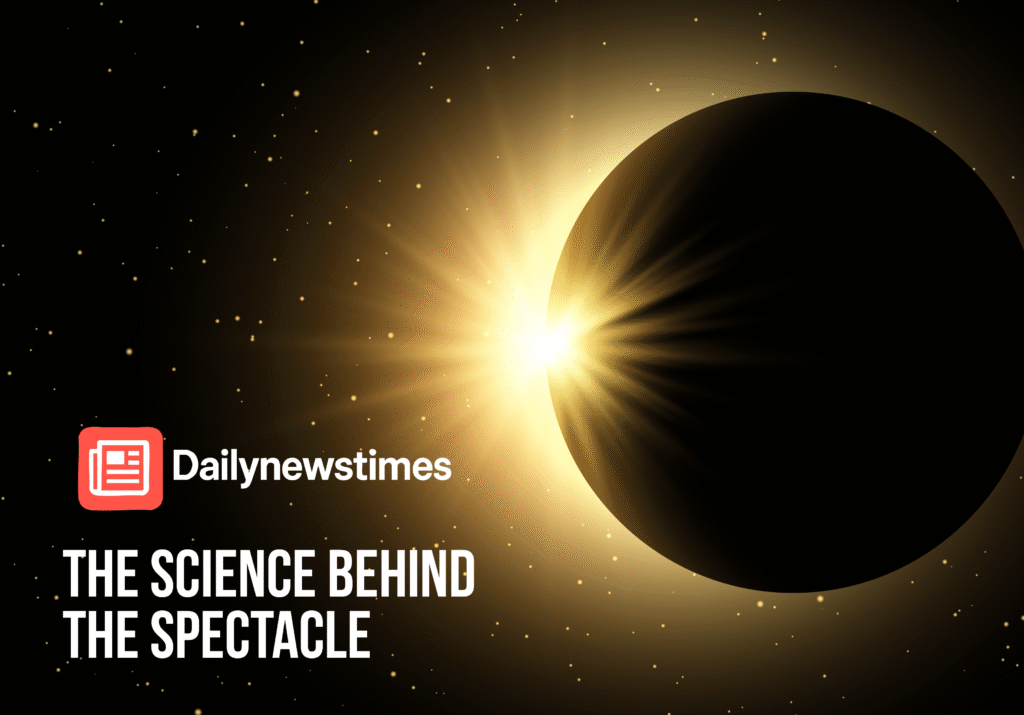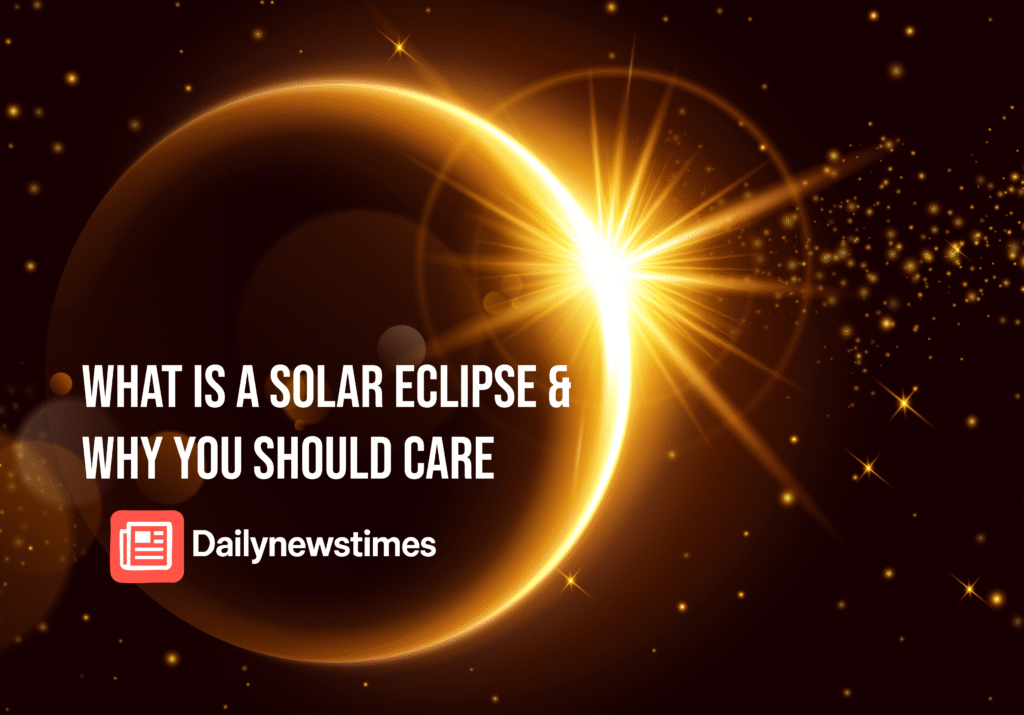A Solar Eclipse happens when the Moon lines up just right, between the Sun and our Earth, casting a shadow that dims, or completely blocks, the Sun’s light from parts of the planet (Wikipedia). This rare, cosmic event brings together spectacular visuals—with the Sun’s corona peeking out during a total eclipse—and serious science, dating all the way back to tests of Einstein’s general relativity. Plus, it’s a thrill—like, who doesn’t wanna see the “ring of fire,” or midday darkness, huh?
It matters because it’s beautiful, dramatic—and scientifically valuable. During total eclipses, researchers study the Sun’s outer atmosphere (called the corona), test astrophysical theories, and gather rare data (NASA Science). For everyday people, it’s just plain magical. It brings communities together, inspires kids to look up, and honestly—it’s one of those nature moments that stick with you forever.
Types of Solar Eclipses
There’s more than one type of eclipse, and each one brings its own vibe. Here’s a quick tour of what you might catch in the sky.
Total Solar Eclipse
This is the big one. The Moon completely covers the Sun, turning day into what feels like night. It’s surreal. Viewers standing in the Moon’s direct shadow—called the umbra—experience what’s known as “totality.” The sky dims, birds go quiet, and you can actually see the Sun’s fiery outer layer. Mind-blowing stuff.
Want the science? Check out NASA’s eclipse types guide.
The April 8, 2024 eclipse was a perfect example, sweeping across North America, from Mexico through Texas and all the way to Maine (NSF event page). Totality lasted up to 4 minutes in some spots. It was huge.
Annular Solar Eclipse
In this case, the Moon is a little farther from Earth, so it doesn’t quite block the Sun completely. Instead, you get a glowing “ring of fire.” It’s bright, bold, and beautiful—but not as dark as a total eclipse.
The October 14, 2023 eclipse gave people across the U.S. and Central America that dazzling ring effect (Wikipedia). Want a breakdown? Adler Planetarium explains it well.
Partial Solar Eclipse
This one’s more common. The Moon covers just a slice of the Sun. It’s still cool to see—but not quite as dramatic. You’ll need eclipse glasses either way, but you won’t see totality or that ring.
Read more about it on NASA’s eclipse page.
Hybrid Solar Eclipse
This one’s the unicorn. It shifts from annular to total and back again. Super rare—only about 5% of eclipses are hybrids. If you’re lucky enough to catch one, you’re in elite company.
The AAS eclipse glossary breaks down the science behind it.
The Science Behind the Spectacle

Moon’s Orbit & Size Illusion
The Moon’s orbit isn’t a perfect circle. It’s slightly tilted, and a bit oval-shaped. That’s why we don’t get an eclipse every single month. Only when the Sun, Moon, and Earth align during what’s called eclipse season, does the magic happen.
And the distance matters. When the Moon is closer to Earth (perigee), it looks bigger and can block the Sun fully. When it’s farther away (apogee), it’s smaller—hence, that bright ring.
For a great explanation, check out this guide from Adler Planetarium.
Shadow Zones
During an eclipse, the Moon casts three shadows:
- Umbra – where you get a total eclipse.
- Penumbra – you’ll see a partial eclipse here.
- Antumbra – this is where the ring of fire appears.
You’ll also notice strange, wavy lines dancing on the ground just before and after totality. Those are shadow bands, and they’re wild to watch. Learn more on Wikipedia.
Eclipse Patterns
Solar eclipses repeat in cycles. One of the most famous is the Saros cycle, which runs about 18 years. There’s also the Exeligmos cycle, which is roughly three Saros cycles (54 years) and produces nearly identical eclipses in the same area.
Wanna geek out? Here’s the Wikipedia breakdown on Exeligmos, or dive into NASA’s eclipse catalog.
Safety First – Seriously
No joke—looking at the Sun during an eclipse without proper protection can seriously damage your eyes.
- Only use ISO 12312‑2 certified eclipse glasses.
- Regular sunglasses? Nope. Not even close.
- During totality, and only during totality, it’s safe to take the glasses off—but be 100% sure you’re in the path, and put ’em back on when it ends.
- Don’t forget—you can make a pinhole projector too. It’s safe, simple, and fun for kids.
For more on eclipse safety, check out NASA’s official guide and National Weather Service safety info.
Eclipses in History & Culture
Humans have been watching eclipses for thousands of years. Ancient Chinese astronomers documented them as early as 400 BC. Some cultures saw them as divine warnings. Others thought the sky was being eaten.
But eclipses aren’t just myths. In 1919, scientists confirmed Einstein’s theory of general relativity during a total eclipse, when starlight bent around the Sun—just like his equations said it would.
Want to learn how culture and science mix during eclipses? This TIME article covers some fascinating stories.
Upcoming Eclipses You Should Know About
Mark your calendars—here are two big ones:
- April 8, 2024 – A major total eclipse. Crossed Mexico, then Texas, and finished in Maine. Millions saw it live. Check NSF’s coverage.
- October 14, 2023 – An annular eclipse that brought the ring of fire across parts of the U.S. and Central/South America (NPS official guide).
Want to know if one’s coming to your area? Use NASA’s interactive maps.
FAQs
How often do solar eclipses happen?
Globally? Every 18 months or so. But in one spot? Maybe every 375 years. Crazy, right? (Wikipedia)
Can I see the Sun’s corona any other time?
Nope. Only during totality, when the Moon blocks the Sun’s glare. (NASA)
What’s the longest eclipse ever?
The one coming on July 16, 2186, will last about 7 minutes and 29 seconds. Epic. (Wikipedia)
What are shadow bands?
They’re moving, wavy shadows caused by atmospheric turbulence—seen just before or after totality. (Wikipedia)
Pros & Cons of Eclipse Travel
| Pros | Cons |
|---|---|
| Mind-blowing view of nature | Long travel or huge crowds |
| Rare photo ops & science moments | Weather might ruin it |
| Educational, fun, unforgettable | It’s quick—gone in minutes |
Tips for Eclipse Chasers
- Plan early. Hotels, campsites, even roads—fill up fast.
- Check weather. Historical cloud maps help pick better spots.
- Pack smart. Glasses, snacks, water, power banks. Trust me.
- Go with friends. Makes the waiting—and watching—way better.
- Use apps. NASA’s got some amazing eclipse tools.
- Capture it safely. Solar filters for cameras or phones are a must.
Official Tools & Trusted Links
- NASA’s Eclipse Portal – interactive maps, past and future dates.
- NOAA’s Solar Eclipse Tracker – satellite and climate info.
- NPS Solar Viewing Guides – find eclipse events in national parks.
- Adler Planetarium Eclipse Guide – visuals, history, and kid-friendly explanations.
- GLOBE Observer App – citizen science for eclipse fans.
Final Thoughts – Don’t Miss This
A Solar Eclipse isn’t just something to see—it’s something to feel. When the sky dims, the air cools, and the world goes quiet, it’s a humbling reminder of just how small we are… and how awesome the universe can be.
So prep your glasses, plan your trip, and tell your friends. Eclipses are rare, beautiful, and oh-so worth it. Whether it’s total, annular, or partial—look up. It might change how you see everything.


